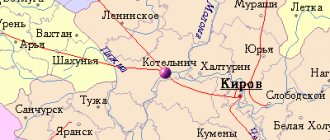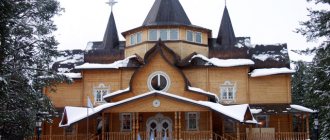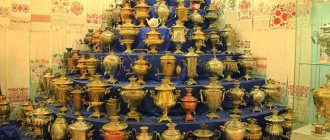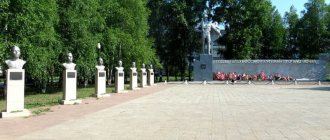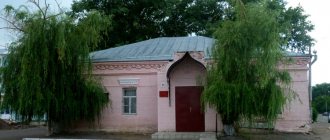Ustyuzhna: areas, recreation, excursions, museums and churches, cuisine and restaurants, shopping and shops, attractions of Ustyuzhna.
- Last minute tours
to Russia
“Gentlemen, I have the most unpleasant news for you! An auditor is coming to see us.” Anyone who doesn’t know these lines by heart has apparently slept through all their literature lessons at school. Meanwhile, it was Ustyuzhna that became the prototype for the city of N. from Gogol’s immortal comedy. However, in Russian history, Ustyuzhna is famous not for the incidents that happened in the city, but for the long traditions of blacksmithing, mining and rich history - the first mention of the city appeared back in 1252.
A little history
Once upon a time the city was called Ustyug-Zhelezny, because the city stood on an “iron field” of huge deposits of ore, which the local population had long used. To some extent, this city is the cradle of Russian metallurgy. The level of blacksmithing in Ustyuzhna was so high that under Peter the Great the city was one of the largest centers of arms making, surpassing even Tula. Many Ustyun residents later became the founders of blacksmithing in the Urals.
Safe and sound in the center of Ustyuzhna there is a private hotel where Platonov-Volkov once stayed and robbed the city mayors completely.
Since ancient times, the city has held the “Iron Field” blacksmith fair in July. Here you can see the prowess of blacksmiths, buy souvenirs and jewelry made of various metals, and see with your own eyes how steel was forged and smelted in the past. Here you can also appreciate the work of gunsmiths who make hunting rifles and demonstrate restored weapons. In addition to steelworkers and blacksmiths, Ustyuzhna is famous for its builders, tanners, carpenters and shipbuilders, who made ships for the fleet of Peter the Great.
A little history of Ustyuzhna. Curious facts
Fact number 1, the most ancient.
They sometimes say that people have lived somewhere from time immemorial, that is, from those times that no one remembers for sure and can’t even be found in the chronicles. This is just about Ustyuzhna. Let's start with the fact that, according to archaeological excavations, in these places there was one of the most ancient sites in the Russian North. This means that people settled on the high banks of the Mologa immediately after the end of the Ice Age. Also, no one knows for sure the exact date of the founding of the city. In the Novgorod chronicles, Ustyuzhna is mentioned in the middle of the 14th century, in Uglich - in the middle of the 13th century. Therefore, the founding year is considered to be 1252. But this is not certain.
Fact number 2, the most beautiful.
How do you feel about the letter Z? In our opinion, it sounds very nice. That’s why the history of the origin of the city’s name seems fascinating to us. No, it’s not about legends, but about the beauty of the Russian language. The city is located on the Mologa, in the place where the tributaries Izhin and Vorozh flow into it. Therefore, initially the city was called Ust-Izhina, but gradually transformed into Ustyuzhna Zheleznopolskaya, and then simply into UstyuZhna.
Fact number 3, the most official.
Because what could be more official than the city’s coat of arms? And the coat of arms of Ustyuzhna is unusual. At first glance, it seems that there is a pile of stones on the red field. No, these are not stones at all, but “iron kritsy, which the inhabitants of this city trade in, and get this iron from the nest ore, which the surroundings of this city abound in.” Yes, Ustyuzhna for a long time was the center of production and processing of swamp and lake iron ore, and Izhinsky The ironworks provided the entire Russian army with muskets and cannons. Until Peter I transferred all production to Tula and the Urals.
Fact number 4, the most museum-worthy.
Ustyuzhna is often called a museum city. Indeed, despite the Soviet quarters in the southeast, the historical part of the city has remained almost untouched, dating back to the 18th century and even earlier. Therefore, wandering here is a pleasure, as if you are transported back in time to the age of stately stone churches, rich merchant houses, peasant settlements, noisy fairs and measured provincial life. This is better than any 3D visualization.
Fact No. 5, the most renamed.
According to residents, not a single city suffered from renaming as much as Ustyuzhna: “Not a city, but some kind of set of political toponyms.” St. Lenina smoothly turns into Karl Marx, st. Kommunarov, Proletarskaya, lane. Free worker, etc. There is even an alley of cosmonaut Valentina Tereshkova. The historical name was returned only to Cathedral Square, which in Soviet times bore the name of the Victims of the Revolution.
“It’s high time not only to think about it, but also to return the streets to their original names. Bolshaya Moskovskaya, Bolshaya Novgorodskaya, Kozmideyansky lane, Peterburgskaya street. They sound much more beautiful."
Surprisingly, the city itself never changed its name.
Entertainment and attractions in Ustyuzhna
You can start your acquaintance with a visit to the ancient settlement - an archaeological monument of the 10th-12th centuries and a memorial sign, which was installed here in 2002 in honor of the 750th anniversary of the city. By the way, nearby there is a private hotel safe and sound, where Platonov-Volkov once stayed and robbed the city mayors completely. If you wish, you can stay there yourself.
You should definitely visit the Ustyug churches: the huge Mother of God Nativity Cathedral with white stone walls, the Temple of the Icon of the Kazan Mother of God, which was built in the Stroganov style, the Annunciation Church on the banks of the Vorozha River.
Ustyuzhensky Museum of Local Lore
If you go to the Ustyuzhensky Museum of Local Lore (Cathedral of the Nativity of the Virgin), you can look at the collection of paintings of Ancient Rus' (there is an iconostasis made by the masters of the Armory Chamber), at blacksmith's products, and look at 1000-year-old porcelain.
Batyushkov Museum-Estate
Another famous place is the museum-estate of the Batyushkovs and A.I. Kuprin, which are located 15 km from the city (Danilovskoye village). It was here that Kuprin worked on his famous “Garnet Bracelet”. If you sign up for an excursion, you can not only walk around the ancient park of the estate, but also take part in the game program. By the way, Kuprin and Batyushkov evenings are held here every year.
Golden Ring of the Vologda Region - Ustyuzhna
Ustyuzhna is a city in the Vologda region on the Mologa River with a population of just over 10 thousand people. Ustyuzhna is the center of the Ustyuzhna district of the Vologda region of the same name, although these regions were included in the Vologda region only under Soviet rule.
The Ustyuzhensky district borders on the Cherepovets, Kaduysky, Babaevsky and Chagodoschensky districts of the Vologda region, the Pestovsky district of the Novgorod region, as well as the Sandovsky and Vesyegonsky districts of the Tver region.
Historically, the city of Ustyuzhna and Ustyuzhensky district were part of the Novgorod province and included the territory of modern Ustyuzhensky and Chagodoshchensky districts of the Vologda region, Pestovsky district of the Novgorod region and Pikalevsky district of the Leningrad region. The first mention of the city of Ustyug Zhelezny, located at the mouth of the Izhina River, dates back to 1253. Later the city was called Ustyuzhnaya Zheleznopolskaya, and only in the 19th century received its modern short name. The former names of the city emphasized that intensive mining of iron ore was carried out in these parts, which was processed near the city in the “iron field”. The majority of the population of the city and surrounding areas was engaged in the extraction and processing of iron ore. The city was repeatedly raided, however, it was never captured. The most serious attack occurred in 1609, when the city was attacked by the troops of False Dmitry II. However, the city was defended. In Peter's times, arms factories operated in Ustyuzhna, supplying the Russian army on a par with the famous Tula gunsmiths. Among other things, weapons factories cast cannonballs. Later, when iron ore reserves were depleted, other industries appeared in the city related to glass melting, shipbuilding, logging, and brick production. Currently, among the industrial enterprises in Ustyuzhna, only a flax mill and a timber mill operate.
Ustyuzhna is one of the few provincial cities in central and northern Russia that has brought to this day all the flavor of the old “pre-revolutionary” classical province. Before the October coup, there were 20 Orthodox churches in the city. During Soviet times they were closed, some of them were destroyed. To this day, seven temples have reached us, some of which require serious restoration. In the very center of the city (on Cathedral Square) are the Annunciation Cathedral and the Church of the Resurrection, as well as the Nativity Cathedral, in the building of which there is a local history museum. Closer to the exit to Zvana and Vesyegonsk (at the fork of Gagarin and Karl Marx streets) the majestic Kazan Church is located. Closer to the old Settlement (near the corner of Krasnye Zori Street and Sennaya Lane) there are two more churches - Trinity and St. Basil the Great. The historical Settlement itself, where the ramparts have been preserved, and a monument was erected in honor of the defense of the city from the troops of False Dmitry, is located between the Mologa and Izhina rivers. Finally, on the left bank of the Mologa River (Dekabristov Embankment) there are the remaining two churches - Pokrovskaya and Uspenskaya. Among other attractions of the city, several well-preserved stone mansions in the central part should be noted, and wooden architecture (including the most beautiful well heads and water towers) also deserves attention. In addition to the monument to the defenders of the city near the historical Settlement, other monuments have been erected in the city - the traditional V.I. Lenin, as well as the merchant Y.M. Pozdeev, who lived in the city in the 18th century and built several churches, hospitals and schools. Both monuments are located in the center near Cathedral Square. The former estate of the Russian poet K.N. also deserves the traveler's interest. Batyushkova, located in the village of Danilovskoye (15 km south of the city on the road to Sandovo). A.I. often visited the estate. Kuprin. Today there is a literary museum in the estate. Another estate has been preserved in the village of Mikhailovskoye, which is near the exit from the city to Sandovo.
The life of the city in all centuries has been connected with the rivers on which it is located. In addition to the grandiose Mologa and its tributary Izhina, at the mouth of which the city arose, another river flows within the boundaries of modern Ustyuzhna - Vorozha, on which there is a pond near the city center. The Mologa River today is practically unnavigable, although in more ancient times it was always a major transport artery. Various cargoes were transported along it to the cities of Mologa and Rybinsk, from where they were sent down or up the Volga, or up the Sheksna to Beloozero. After the Rybinsk Reservoir was filled, when the Mologa Bay was formed, which flooded a large area in the vicinity of the neighboring city of Vesyegonsk (including part of the city itself), the water level in the river increased within the boundaries of Ustyuzhna, which made Mologa navigable by modern standards. However, in recent years, Mologa has become noticeably shallower, and today there is no regular navigation on it above Vesyegonsk.
Ustyuzhna has historically always been located at the intersection of important roads, which was largely determined by its favorable location on the Mologa River, as well as large-scale iron ore mining. Since ancient times, the Vologda-Tikhvin highway passed through Ustyuzhna, which was the main one. However, during the construction of the new highway A-114 Novaya Ladoga - Tikhvin - Cherepovets - Vologda, the ancient route was straightened and bypassed Ustyuzhna. Sections of the old highway now connect Ustyuzhna with this new highway. Moreover, only the exit in the direction of Cherepovets - Vologda (which now bypasses the settlements of Ogib, Gromoshikha and Lentyevo) is completely paved. This exit is used both when traveling to Cherepovets and Vologda, and when traveling to Tikhvin and St. Petersburg, since the second part of the old Ustyuzhna-Mochala highway (providing a shorter exit in the direction of Tikhvin) in some places does not have an asphalt surface. You can also go through the A-114 highway to Kaduy, Chagoda, and Pikalevo. Not far from the exit from the city to this highway (near the village of Lentyevo) the road to Babaevo begins. Other roads connect Ustyuzhna with the regional centers of neighboring regions - Vesyegonsky, Sandovo, Pestovo. The best of these roads leads to Pestovo and further to Borovichi and Valdai, through which you can access the Moscow-St. Petersburg highway. This road is paved throughout its entire length. Through Pestovo you can also go to Khvoinaya (the road in some places is without asphalt (from Bryakunovo to Zvyagino), but regularly graded and passable at any time of the year), as well as to Lesnoye and further to Tver (between the villages of Vyatka and Lesnoye - there is also a piece of unasphalted, but the regularly maintained road is about 20 km long). The road to Vesyegonsk has an unpaved section of about 20 km from Bolshoy Ovsyannikov (the border of the regions) to the turn to Nikulino. The road to Sandovo also has an unpaved section from the border of the regions to Sandovo - only 7 km of regularly corrected grader (this section is planned to be asphalted in the coming years). Through Vesyegonsk and through Sandovo you can go to Krasnoye Kholm and then to Sonkovo or Bezhetsk. Travel to Moscow is carried out through Borovichi, or through Bezhetsk (then to Kalyazin or Tver). Another local road is laid along the old highway Ustyuzhna - Zvana - Lyubegoschi - Kesma, which was the shortest route to Krasny Kholm and further to Tver. Today this road goes only to the village of Zvany, located on both banks of the river of the same name. The left bank part of Zvana belongs to the Vologda region, and the right bank part to the Tver region. There is no road bridge across the Zvany River, which separates parts of the village. Further in the Tver region, the remains of the old highway exist in the form of a grader road. You should also note that travel to the village. them. Zhelyabova (Zhelyabovo), located on the right bank of the Mologa, is carried out not through the village of Lentyevo (at the asphalt exit to the A-114 highway), where there is only a pedestrian bridge over the Mologa, but along a separate road that branches off near the exit to Vesyegonsk, and goes along the right shore to Zhelyabovo and Modno. From Ustyuzhna there once also existed a grader road north to the village of Orel. Despite the fact that road signs in this direction still remain, the road is overgrown and practically not used, since the village of Orel is located near the modern A-114 highway, and access to it is via this highway.
Intercity buses depart from Ustyuzhna to St. Petersburg, Cherepovets, Vologda. Suburban services include bus service along main roads. Through the Vologda exit there are buses to Merezha (via Orel) and Novaya Derevnya (via Orel, Mochala). Through another part of the old Tikhvinsky tract (direction to Mochala) buses go to Solovtsovo and Yakovlevsky. On the highway to the city of Pestovo, the bus destinations are Lyubotovo, Krutets, Astashkino and the city of Pestovo itself. In the Vesyegonsk direction, buses go to the village of Chernaya (with a stop in Slavynevo) and the city of Vesyegonsk. In addition to Zhelyabovo, buses to Krasino (via Modno) also follow the Zhelyabovsky exit. In the Sandovsky direction there are routes to Konyukhovo, Lyubotovo, Kresttsev, Sychevo, Emelyanikha and Sandovo. Buses also run to Zvana. The bus station is located almost in the very center of the city - in Kommunistichesky Lane between Lenin and Proletarskaya streets.
Since the railway line to Ustyuzhna from Vesyegonsk station, designed at the beginning of the twentieth century, was never built, there is no railway in Ustyuzhna. Despite this, the city of Ustyuzhna is an important transport center, road junction and transit point of the “Savelovskaya wilderness”. The nearest railway stations to Ustyuzhna are in Kaduy, Cherepovets, Pestovo, Sandovo and Vesyegonsk.
The distances from Ustyuzhna to the nearest large and key settlements by road are as follows: Lentyevo (A-114) – 21 km; Kaduy (via A-114) – 108 km; Cherepovets (via A-114) – 118 km; Babaevo (via A-114) – 93 km; Chagoda (via A-114) – 108 km; Pikalevo (via A-114) – 183 km; Tikhvin (via A-114) – 231 km; Pestovo – 47 km; Borovichi (via Pestovo) – 165 km; Valdai (via Pestovo, Borovichi) – 252 km; Okulovka (via Pestovo, Borovichi) – 201 km; Lesnoye (via Pestovo) – 88 km; Maksatikha (via Pestovo, Lesnoye) – 169 km; Vesyegonsk – 57 km; Sandovo – 43 km; Krasny Kholm (via Sandovo) – 112 km; Krasny Kholm (via Vesyegonsk) – 136 km.
You can read more about Ustyuzhna here:
- Page about Ustyuzhna on the website “Guide to Russian Cities”
- In historical Rus': Ustyuzhna
- Page about Ustyuzhna on the Vologda website
Fishing and hunting
Fishermen often come to Ustyuzhna - the local river, Mologa, is famous for the fact that it is home to sturgeon, pike, sterlet and stellate sturgeon. Sports competitions among professional fishermen are regularly held here, as well as competitions for the best fish soup and smoked fish.
By the way, for those who want to go fishing, it is better to go in the direction of the village of Zhelyabovo, which is located about 12 km from the city itself. Here the river is deeper (from 2 to 4 m) and there are more fish.
The road passes through small villages, with good surface. However, there are a lot of speed bumps, so being reckless is more expensive. When the asphalt ends, the road deteriorates sharply, so it is better to go fishing in winter: then the roads are much smoother.
Another popular type of recreation is hunting, which has always been a traditional pastime for local landowners. The forests of the area are inhabited by hares, foxes and hazel grouse. Winter hunting is especially popular, when hunters roam the forests on skis, tracking down game. You can hunt in areas controlled by Lynx LLC. For additional information, you can contact the Ustyuzhan Hunters Society.
How to get from St. Petersburg to Ustyuzhna
The distance between St. Petersburg and Ustyuzhnaya is 430 kilometers. If you go by personal car, the road is very simple. Along the E105 highway (Kola) to the intersection with the Volkhov River. After the river, turn left to Tikhvin and onto the A-114 highway to Cherepovets. Shortly before the village. Zhelyabov will need to turn left again - straight towards Ustyuzhna.
Buses to Ustyuzhna depart from the bus station on the Obvodny Canal daily and regularly. A few flights around 8am and a few around noon. Travel time is about 7 hours.
There is no railway connection between St. Petersburg and Ustyuzhnaya, because there is no railway in Ustyuzhnaya.
First attack
The Ustyuzhans, together with the Belozers, gave their first battle to the “Lithuanian people” on the approaches to Ustyuzhna, near the village of Bateevki. But the poorly prepared local militia lost the battle to the Lithuanians.
After the defeat at Bateevka, the city’s defenders did not lose heart. The worse the defeat, the hotter the work went. Everyone, both old people and children, worked to build earthen ramparts and wooden walls. Blacksmiths tirelessly forged self-propelled guns, arrowheads and spearheads.
On February 3, 1609, the sentinels “taught a flash in the fort, as if Lithuania and the Poles were coming to the fort.”
Colonel Mikulai Kosakovsky, who commanded a detachment of Tushins (which included “Lithuanians, Poles, Cherkassy, Germans, Tatars, Zaporoskiy Cossacks, and thieves from many Russian cities”), did not at all expect to see five-meter-high log walls in front of him. Only a month ago he was informed that Ustyuzhna had no fortifications and it would not be difficult to get provisions and other supplies there. And here it is - on you.
The first attack of the “thieves’ people” failed. But they were not going to give up so easily - having plundered and burned the houses and temples that remained outside the fortress walls, they retreated.
Heyday
By this time, changes had occurred in the Moscow principality that radically affected the life of Ustyuzhna: Novgorod, whose lands it bordered, was annexed to Moscow, and our city ended up in. From a border fortified point, it gradually turned into a large industrial - let's not be afraid of this word - center. Rich deposits of swamp ore contributed to this. Naturally, the main industry of Ustyuzhna was iron making. By the second half of the 16th century, there were about 6,000 inhabitants, of which 77 kept forges (for comparison, in Tula, which is much more famous in this regard, there were then only 30 forges).
The city grew rich, but all its buildings, including churches and monasteries, remained wooden.





